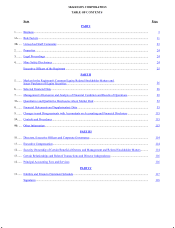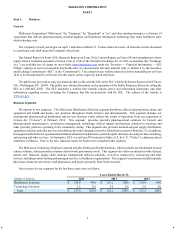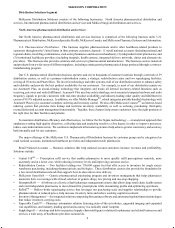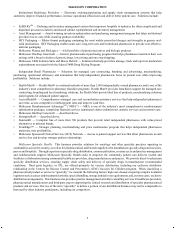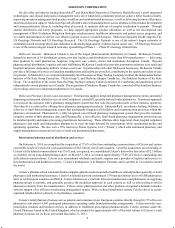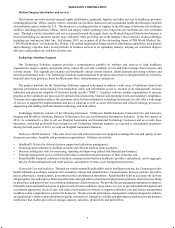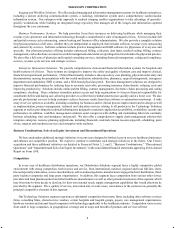McKesson 2014 Annual Report Download - page 15
Download and view the complete annual report
Please find page 15 of the 2014 McKesson annual report below. You can navigate through the pages in the report by either clicking on the pages listed below, or by using the keyword search tool below to find specific information within the annual report.
McKESSON CORPORATION
12
Healthcare Fraud: We are subject to extensive and frequently changing local, state and federal laws and regulations relating
to healthcare fraud, waste and abuse, and the government, both state and federal, continues to strengthen its position and scrutiny
over practices involving fraud, waste and abuse affecting Medicare, Medicaid and other government healthcare programs. Our
relationships with pharmaceutical and medical-surgical product manufacturers and healthcare providers, as well as our provision
of products and services to government entities, subject our business to laws and regulations on fraud and abuse, which among
other things: (1) prohibit persons from soliciting, offering, receiving or paying any remuneration in order to induce the referral of
a patient for treatment or for inducing the ordering or purchasing of items or services that are in any way paid for by Medicare,
Medicaid or other government-sponsored healthcare programs; (2) impose a number of restrictions upon referring physicians and
providers of designated health services under Medicare and Medicaid programs; and (3) prohibit the knowing submission of a
false or fraudulent claim for payment to, and knowing retention of an overpayment by, a federal healthcare program such as
Medicare and Medicaid. Many of the regulations applicable to us, including those relating to marketing incentives, are vague or
indefinite and have not been interpreted by the courts. They may be interpreted or applied by a prosecutorial, regulatory, or judicial
authority in a manner that could require us to make changes in our operations. If we fail to comply with applicable laws and
regulations, we could become liable for damages and suffer civil and criminal penalties, including the loss of licenses or our ability
to participate in Medicare, Medicaid and other federal and state healthcare programs.
Reimbursements: Both our profit margins and the profit margins of our customers may be adversely affected by laws and
regulations reducing reimbursement rates for pharmaceuticals, medical treatments and related services, or changing the
methodology by which reimbursement levels are determined. For example, the Patient Protection and Affordable Care Act and
the Health Care and Education Reconciliation Act (collectively the “Affordable Care Act”), signed into law in 2010, revised the
federal upper limits for Medicaid reimbursement for multiple source generic drugs available for purchase by retail community
pharmacies on a nationwide basis to a limit of not less than 175% of the weighted average (determined on the basis of utilization)
of the most recently reported monthly average manufacturer price (“AMP”) using a smoothing process. The Centers for Medicare
and Medicaid Services (“CMS”) has proposed new rules for calculating AMP (“Revised AMP”) and is also offering states the
option to replace traditional reimbursement metrics for certain drugs with alternatives such as the average acquisition cost (“AAC”)
method or the national average drug acquisition cost benchmark (“NADAC”). Under AAC and NADAC, reimbursement is based
on the actual acquisition costs from invoiced amounts and from a statistically validated cost of dispensing survey. States will have
the option of using any of these metrics to determine appropriate Medicaid reimbursement to pharmacies for generic or brand
drugs. We expect that the use of a Revised AMP benchmark or the use of an alternative reimbursement metric, such as AAC or
NADAC, would result in a reduction in the Medicaid reimbursement rates to our customers for certain pharmaceuticals, which
could indirectly impact the prices that we can charge our customers and cause corresponding declines in our profitability.
The federal government may adopt measures that could reduce Medicare and/or Medicaid spending, or impose additional
requirements on healthcare entities. For example, under the terms of the Budget Control Act of 2011, an automatic 2% reduction
of Medicare program payments for all healthcare providers became generally effective for services provided on or after April 1,
2013. This automatic reduction is known as “sequestration.” Medicare generally reimburses physicians for Part B drugs at the
rate of average sales price (“ASP”) plus 6%. The implementation of sequestration pursuant to the Budget Control Act of 2011 has
effectively reduced reimbursement below the ASP plus 6% level for the duration of sequestration (which lasts through fiscal 2024
in the absence of additional legislation). Additionally, concerns held by federal policymakers about the federal deficit and national
debt levels could result in enactment of further federal spending reductions, further entitlement reform legislation affecting the
Medicare program, or both. We cannot predict what alternative or additional deficit reduction initiatives or Medicare payment
reductions, if any, will ultimately be enacted into law, or the timing or effect any such initiatives or reductions will have on us.
There can be no assurance that the preceding changes would not have a material adverse impact on our results of operations.


